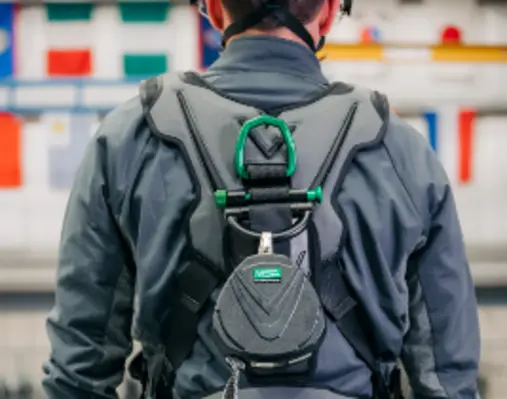Use of temporary horizontal lifelines (THL) is especially common in construction and industrial maintenance work
The construction sector saw more fatal workplace injuries than any other in 2021/22, accounting for 24% of the total. Manufacturing followed at 18%. The most prominent accident category – representing 24% of all deaths at work – was falls from height.
In industrial environments, THLs tend to be used in locations where work at height is needed only occasionally. If there is a frequent need in one place, it makes more sense to install a permanent fall protection system. This may be the case, for example, in regular air conditioner maintenance. THL applications by contrast, could include a one-off machinery repair or a servicing task required just once every few years, making it a more affordable and practical alternative.
To meet the changing needs of construction projects, THLs can be continually moved into different positions.
Expanded lifeline choice
A THL provides the anchorage for a fall protection system whose other essential components are a body harness and a connecting device. The latter, which is often an SRL (self-retracting lifeline) or a PFL (personal fall limiter), connects the worker’s harness to the horizontal lifeline.
In developing the new MSA THL, MSA’s design engineers have opted for galvanised steel cable to maximise durability over webbing, rope or steel cable.
Time savings in installation
A THL must be connected to a firm anchor point at each end. The anchor points are normally beams or other solid structural features of a building. Attachment is usually via anchor straps.
Once attached, the lifeline needs to be locked and tightened. With the MSA solution, toolless locking and tensioning mechanisms are built into the lifeline, speeding up the process by 75% over traditional cable systems. There are no tools or other separate items to carry and potentially drop or lose. In addition, both mechanisms are at the same end of the lifeline, so there is no longer a need to walk back and forth when installing it.
Confident locking and tensioning
A key issue to address is firm locking and correct tensioning. The new MSA system uses coloured visual indicators on its inbuilt locking and tensioning devices clearly show whether the system has been set up correctly and is ready for use.
Quick decisions on clearance
Another aspect on which users want to be confident, is how much clearance height is needed in the set-up for safety in the event of a fall. To date, it has required calculations combining data from the separate lifeline, connecting device and harness user manuals – adding extra time to the job.
MSA has now solved this difficulty by providing its lifeline with easy-to-use charts for which the calculations have already been made. These take into account factors like the number of users connected (one or two), the distance between the anchor points, the type of connecting device used, and whether the lifeline is at foot, chest or overhead level. They quickly point the user to the required clearance for each set of circumstances.
Improved mobility
The MSA system uses flexible, lightweight cable and can be easily carried and set up by one person. Its simplicity, flexibility and adaptability to different circumstances make it ideal for constantly changing work sites and intermittent maintenance tasks.
Its mobility-enhancing design allows two connected workers to pass each other on the line without temporarily disconnecting.
Durability, strength and true value
The strength and durability of MSA’s galvanised steel cable gives workers and their managers greater assurance. This is especially important when lifelines face abrasive, corrosive, dirty or polluted conditions, like those typical of construction and industrial maintenance applications. The MSA lifeline is also tested to a capacity of 140 kg, which exceeds the EU standard of 100 kg.










